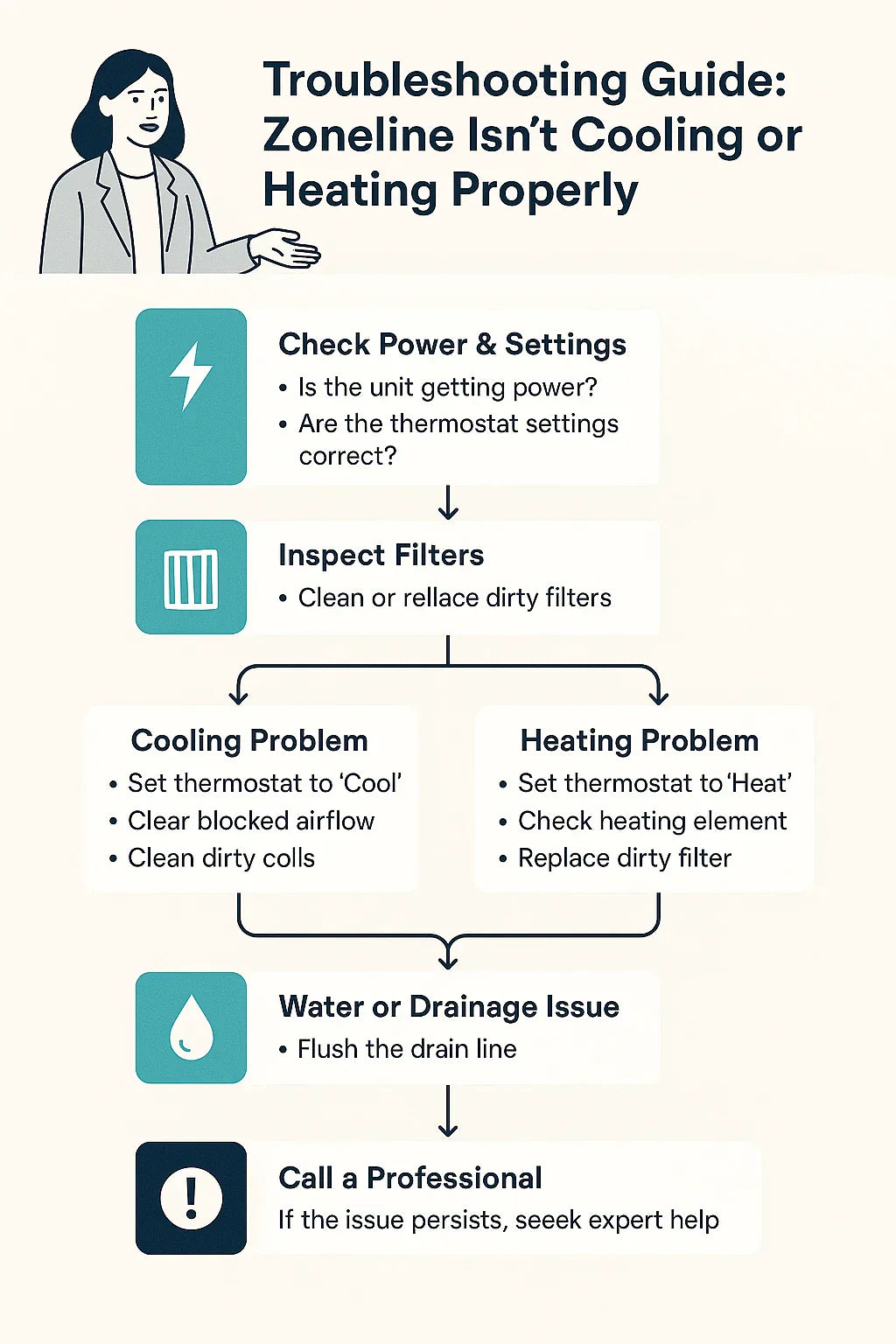A GE Zoneline Vertical PTAC (Packaged Terminal Air Conditioner) is designed for quiet, reliable multi-room comfort. But even the best systems can act up from time to time.
If your Zoneline isn’t cooling or heating properly, don’t panic. Most issues are minor and fixable at home before you need to call in a pro.
This Savvy guide will walk you through step-by-step troubleshooting, covering:
-
Power and thermostat checks
-
Airflow issues (filters, coils, ducts)
-
Cooling-specific problems
-
Heating-specific problems
-
Drainage & water leaks
-
Strange noises
-
When to DIY vs. when to call a professional
⚡ Step 1: Check Power & Settings
Before assuming the worst, start simple.
🔹 Power Issues
-
Breaker tripped? Check your electrical panel for a tripped circuit breaker. Zoneline vertical units usually run on 208/230V dedicated circuits.
-
Unit unplugged? Rare, but confirm connections if recently serviced.
-
Reset needed? Some models have a reset button or require cycling power at the breaker.
🔹 Thermostat Settings
-
Ensure the mode is set correctly (Cool vs. Heat vs. Fan Only).
-
Check the temperature setting. If it’s set too close to room temp, the unit may not engage.
-
Verify fan mode. “Auto” cycles with heating/cooling; “On” runs continuously.
👉 Savvy Tip: Half of “broken AC” calls come down to thermostat settings or tripped breakers. Always start here.
🧹 Step 2: Inspect Filters
Filters are the #1 cause of performance issues.
🔹 Signs of a Dirty Filter
-
Weak airflow.
-
Unit runs but room doesn’t cool or heat.
-
Visible dust on the filter or return grille.
🔹 Fix
-
Remove the filter from the return grille (inside closet).
-
Wash reusable filters with soap + warm water. Let dry before reinstalling.
-
Replace disposable filters.
📌 Fact: ENERGY STAR notes that dirty filters can reduce HVAC efficiency by 15% or more .
👉 Savvy Tip: Keep spares handy and swap monthly during peak use.
❄️ Step 3: Cooling Problems
If your Zoneline isn’t cooling:
1. Not Cooling at All
-
Check thermostat (set to “Cool,” temp below room).
-
Blocked airflow? Clear furniture from supply ducts/return grille.
-
Outdoor airflow blocked? Ensure the condenser vent isn’t obstructed.
2. Cooling but Weak
-
Likely causes:
-
Dirty filter (Step 2).
-
Dirty coils restricting heat transfer.
-
Leaky ducts reducing airflow.
-
-
Fix: Clean coils with coil cleaner or brush; inspect duct seals.
3. Short Cycling (turns on/off quickly)
-
Thermostat near a heat source (lamp, sunlit wall).
-
Oversized unit cooling too fast.
-
Low refrigerant (pro check required).
4. Ice on Coils
-
Cause: Restricted airflow (dirty filter or duct).
-
Fix: Turn off cooling mode, run fan only until ice melts. Clean filter/coils.
👉 Savvy Tip: If you hear the compressor running but no cold air comes out, it’s usually a coil or airflow issue.
🔥 Step 4: Heating Problems
Zoneline vertical PTACs often use electric resistance heating, which is reliable but power-hungry.
1. No Heat Output
-
Thermostat set to “Heat”?
-
Breaker tripped?
-
Heating element burned out (pro replacement).
2. Heat but Weak
-
Dirty filter or ducts blocking airflow.
-
Unit undersized for space during cold snaps.
-
Drafts overwhelming the system (check doors/windows).
3. Strange Burning Smell
-
Dust burning off heating elements at season startup (normal, should fade).
-
Persistent smell = element damage or wiring issue (call a pro).
👉 Savvy Tip: Electric resistance heat is best in mild climates. In very cold regions, bills spike—consider a heat pump PTAC instead.
💧 Step 5: Water & Drainage Issues
🔹 Common Signs
-
Water pooling near closet.
-
Musty odor.
-
Gurgling sounds.
🔹 Likely Causes
-
Clogged condensate drain line.
-
Drain not sloped properly.
-
Condensate pump failure (if installed).
🔹 Fix
-
Flush line with vinegar solution.
-
Use a wet/dry vacuum at the drain outlet.
-
Confirm drain slope is ¼ inch per foot.
📌 EPA guidance: Improper condensate drainage is a major source of mold growth in HVAC systems .
👉 Savvy Tip: Flush the line every spring to prevent summer leaks.
🔊 Step 6: Noise Troubleshooting
🔹 Types of Noises
-
Buzzing: Electrical issue or failing motor.
-
Grinding: Fan or blower motor bearings.
-
Rattling: Loose panel or ductwork.
-
Gurgling: Drain line issue.
👉 Savvy Tip: If noise worsens over time, stop running the unit and call a pro before bigger damage occurs.
⚠️ When to Call a Professional
DIY fixes work for airflow, filters, and drains. But some issues require expert help:
-
Refrigerant leaks (sealed system).
-
Electrical wiring or heating element replacement.
-
Repeated breaker trips.
-
Compressor failure.
-
Water damage from leaks.
📌 HomeAdvisor estimates: PTAC repair costs average $200–$600, while replacement runs $2,500–$4,300 .
👉 Savvy Tip: If repair exceeds 50% of replacement cost, consider upgrading.
🧭 Savvy’s Quick Troubleshooting Checklist
-
✅ Unit has power (breaker & plug checked).
-
✅ Thermostat set correctly.
-
✅ Filters clean.
-
✅ Ducts and returns clear.
-
✅ Coils clean.
-
✅ Drain line flushed.
If all boxes are checked and issues remain → call a technician.
✅ Conclusion: Restore Comfort, Protect Your Investment
Your GE Zoneline Vertical PTAC is designed for long-term comfort, but it needs airflow, clean coils, and clear drainage to work properly.
-
Cooling issues? Think airflow & coils.
-
Heating issues? Check settings & elements.
-
Leaks or noises? Likely drainage or moving parts.
👉 Final Savvy Tip: Prevent most issues with regular maintenance—filters monthly, coils annually, drains each spring. That way, troubleshooting becomes rare, not routine.
In the next topic we will Know more about: How Much Does a Vertical PTAC Cost? Equipment, Installation & Long-Term ROI







